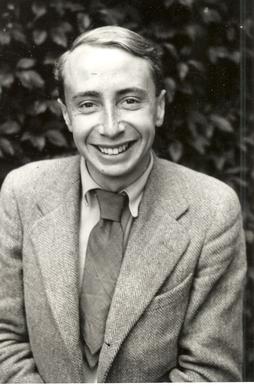Edward Abraham facts for kids
Sir Edward Penley Abraham (born June 10, 1913 – died May 8, 1999) was an English scientist who studied biochemistry. He played a very important part in creating the first antibiotics like penicillin and cephalosporin. These medicines help fight off serious infections.
Quick facts for kids
Sir
Edward Abraham
|
|
|---|---|

Abraham at the Dunn School of Pathology, Oxford in 1939
|
|
| Born |
Edward Penley Abraham
10 June 1913 |
| Died | 8 May 1999 (aged 85) |
| Alma mater | The Queen's College, Oxford |
| Spouse(s) | Asbjörg Abraham (née Harung) |
| Awards |
|
| Scientific career | |
| Institutions | University of Oxford |
| Thesis | Some substituted peptides and Experiments with lysozyme (1938) |
| Doctoral advisor | Sir Robert Robinson |
| Doctoral students | |
| Other notable students | Sir John Walker |
| Influences | Wilson Baker FRS |
Contents
Who Was Sir Edward Abraham?
Edward Abraham was born in Southampton, England, in 1913. He loved science from a young age. He went to King Edward VI School, Southampton. Later, he studied chemistry at The Queen's College, Oxford, and did very well.
He continued his studies at the University of Oxford. There, he earned his advanced degree, called a DPhil. During this time, he was the first to make a special enzyme called lysozyme form crystals. This enzyme was discovered by Sir Alexander Fleming. It was known to help fight bacteria.
Discovering New Medicines
In 1938, Edward Abraham traveled to Stockholm, Sweden, for a year to do more research. When he came back to Oxford, he joined a team. This team was led by Sir Howard Florey. They were working on a very important project: developing penicillin for medical use.
Working with Penicillin
Edward Abraham's main job was to make penicillin pure. He also helped figure out its exact chemical structure. In 1940, he made a big discovery. He found out about something called penicillinase. This was an enzyme that made bacteria resistant to penicillin. It meant the medicine would not work as well.
In 1943, Abraham and Sir Ernst Boris Chain suggested a new structure for penicillin. This idea was later proven correct in 1945. It was confirmed by another famous scientist, Dorothy Hodgkin, using a method called X-ray crystallography.
The Story of Cephalosporin
Later, a scientist named Giuseppe Brotzu sent samples of a special fungus. This fungus had properties that could fight bacteria. Abraham and his colleague, Guy Newton, worked to purify antibiotics from this fungus. They found one called cephalosporin C.
This new antibiotic was special because penicillinase could not break it down. This meant it could fight infections from bacteria that were resistant to penicillin. In 1958, Abraham figured out the structure of cephalosporin C. This was also confirmed by Dorothy Hodgkin.
Abraham found that by changing cephalosporin C slightly, it could become even stronger. He got a patent for this new compound. A patent means he had the legal right to control its use. This led to the first commercial cephalosporin antibiotic, called Cefalotin. Today, there are many types of cephalosporins. Some are still used to treat very tough infections, like certain types of MRSA.
A Life of Dedication
Edward Abraham married Asbjörg Harung from Norway in 1939. They had a son named Michael. Sir Edward and Lady Abraham lived in a place called Badgers Wood. Part of their land, called Abraham Wood, is now looked after by a special trust.
Edward Abraham passed away in 1999. His work on antibiotics made a huge difference in medicine. These important drugs are used all over the world. They treat many infections, like pneumonia, bronchitis, and serious blood infections.
Helping Future Scientists
Because of the patent on cephalosporin, Edward Abraham earned money. He used almost all of it to create two special charities. These charities, like the Edward Penley Abraham Research Fund, support scientific research.
By the year 2000, these charities had given millions of pounds. This money helped the University of Oxford and other places. It helped build new research centers and buildings. It also created scholarships for students. These scholarships help young scientists study for their doctoral degrees at Oxford.
Awards and Recognition
Sir Edward Abraham received many awards for his important work:
- He became a Fellow of the Royal Society in 1958. This is a very high honor for scientists.
- He received the CBE in 1973.
- He was given the Royal Medal in 1973.
- He was made a Knight Bachelor in 1980, which means he could use the title "Sir."
- He also received the Mullard Award in 1980 and the Scheele Award in 1975.

